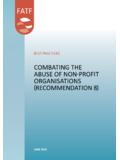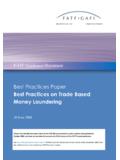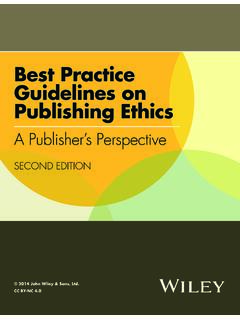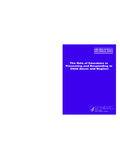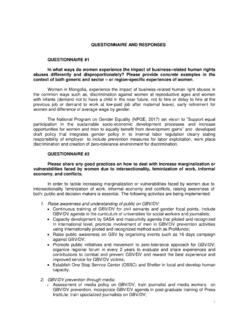Transcription of Promising Strategies to Reduce Substance Abuse
1 Department of JusticeOffice of Justice ProgramsANOJPISSUES & practices REPORTOJPP romising Strategies to Reduce Substance AbusePromising Strategies to Reduce Substance Abuse01-Cover 1-4 11/2/00 3:43 PM Page 1 The research for Promising Strategies to Reduce Substance Abusewas conducted by Drug Strategies , a nonprofit research institute based in Washington, Drug Strate-gies mission is to promote more effective approaches to the nation s drug problems and to support private and public initiatives that Reduce the demand for drugs throughprevention, education, treatment, and law enforcement ( ). Department of JusticeOffice of Justice Programs810 Seventh Street , DC 20531 Janet RenoAttorney GeneralEric H. Holder, Attorney GeneralDaniel MarcusActing Associate Attorney GeneralMary Lou LearyActing Assistant Attorney GeneralOffice of Justice ProgramsWorld Wide Web Home grant and funding information Department of Justice Response Center1 800 421 6770 NCJ 18315201-Cover 1-4 11/2/00 3:43 PM Page 2 Promising Strategies to Reduce Substance AbusedOffice of Justice ProgramsSeptember 2000 ContentsForeword.
2 VExecutive Summary.. viiOverview .. ixPrevention .. 1I. Teaching Prevention in Schools .. 2II. Reaching Youths Outside School.. 7 III. Reaching High-Risk Groups .. 11IV. Building Family Bonds .. 15V. Empowering Communities .. 20 Treatment.. 27I. Family-Based Treatment.. 28II. Rehabilitating Criminal Offenders .. 34 III. Assessing and Treating Adolescents .. 39IV. Connecting with the Community .. 43 Law Enforcement .. 49I. Community Policing .. 50II. Problem-Oriented Policing .. 54 III. Reducing Drug Availability .. 57An OJP Issues & practices ReportiiiPromising Strategies to Reduce Substance AbuseIV. Alternatives to Incarceration.. 63V. Alcohol-Related Approaches .. 68 Conclusion .. 75 Endnotes .. 77ivAn OJP Issues & practices ReportForewordDrug and alcohol Abuse , drug trafficking, and related criminal activity remain seri-ous problems that affect the lives of most Americans.
3 Under the leadership of PresidentClinton and in cooperation with the Office of National Drug Control Policy, the of Justice has promoted and pursued an approach that combines preven-tion, treatment, and enforcement to break the cycle of Substance Abuse and Strategies to Reduce Substance Abuseillustrates this approach through examplesof programs that have been adopted successfully by communities across the see this volume as a toolbox for elected state and local officials, law enforcement,prosecutors, judges, community organizers, and other policymakers. It contains practicalinformation about a range of proven and Promising Strategies to Reduce Substance Abuse . Several themes emerge from the profiled programs that match the themes found inthe companion volume, Promising Strategies to Reduce Gun Violence,published in 1999by the Office of Juvenile Justice and Delinquency Prevention.
4 One is that the criminaljustice system can and should be used to improve public health as well as public is that providing treatment for drug Abuse is a cost-effective means of reducingthe heavy burden that both drug Abuse and incarceration impose on society. If the proxi-mate cause of much criminal activity is the desperate need to feed a drug habit, if crimi-nal activity is frequently committed under the influence of drugs and alcohol, if thepsychoactive effects of drug Abuse lead people to violent and antisocial conduct, thenusing the criminal justice system to hold people accountable for their deeds but also toenable them to change their behavior can lead to reduced recidivism, safer communities,and healthier and more productive has long been my goal to develop a continuum of interventions for substanceabuse offenders.
5 Incarceration is just punishment for those who commit acts of drugtrafficking, for those who do violence to innocent victims, and for those who repeatedlybehave in a manner that endangers our safety. Many times, however, the primary victimsof Substance Abuse are the defendants themselves who need help turning their livesaround. Drug court programs, for example, are especially effective in dealing withsubstance-abusing defendants. The prevention, treatment, and law enforcement strate-gies described in the following pages embody this continuum of programs also demonstrate how crucial broad collaboration is in forgingsound and effective Strategies . This collaboration has different components: federal, state,and local governments pooling their resources; education, health, and police officialssharing ideas and data; and government, business, and nonprofit sectors building coali-tions, all in service of the common goal of combating Substance Abuse .
6 The problemstouch us all, and we all need to be part of the solutions. I am sure that every communitycan find in these pages an example of a program that will work for it. I hope everyonewho reads this will be inspired to dedicate time and energy to support the appropriateorganizations, or to create new ones, to implement these tested and Promising strategiesto Reduce Substance RenoAttorney Department of JusticeAn OJP Issues & practices ReportvAn OJP Issues & practices ReportviiExecutive SummarySubstance Abuse is one of the most pervasive problems facing our nation, costingover $275 billion in health care costs, lost productivity, related crime, and other socialcosts, and contributing to over 130,000 deaths each year. To help communitiesaddress the devastating effects of illicit drug and alcohol Abuse , Promising Strategies toReduce Substance Abusehas been developed to highlight best practices in prevention,treatment, and law , treatment, and law enforcement Strategies , discussed in separatechapters, act in concert with one another, comprehensively addressing substanceabuse in various contexts.
7 Collaboration among law enforcement, health, and socialservice agencies can help Reduce demand, which fuels drug trafficking activities, ofteninvolving violence and crime. Treating addicts and preventing the onset of drug usecan complement law enforcement efforts to Reduce research in drug Abuse prevention over the last two decades has identi-fied key elements of successful programming, discussed in the Prevention risk and protective factors is an essential component of successful pre-vention for alcohol and other drug Abuse continues to evolve as more islearned about tailoring treatment to specific populations. Advances have been madein pharmacological treatments and in treatment for women, adolescents, and otherspecific populations. Creating a continuum of care from prison into the community,incorporating HIV prevention in treatment, and delivering essential support services,such as job counseling and child care, are elements of the new approaches to sub-stance justice can have significant impact in reducing illicit drug and alcoholabuse.
8 Law enforcement initiatives addressing Substance Abuse and related crime arenow working more intimately with communities to solve local problems. Local lawenforcement also collaborates effectively with federal anti-drug agencies, forming taskforces to combat high rates of drug-related Strategies to Reduce Substance Abuseis intended to serve as a guide tocommunities by identifying the core elements of Promising Strategies and providingexamples of programs that are making a difference locally. An OJP Issues & practices ReportixOverviewPromising Strategies to Reduce Substance Abuse is an assessment of the most effec-tive Strategies used nationwide to Reduce illicit drug and alcohol Abuse and relatedcrime. The report is intended to serve as a guide to communities by identifying thecore elements of Promising Strategies and illustrating these Strategies with examplesof programs that are making a difference locally.
9 Programs were chosen to representurban, suburban, and rural important trend evident in many of the effective Strategies and programs isa close coordination between law enforcement, treatment providers, and preventionprofessionals to address Substance Abuse and related problems. These partnerships arevital to the success of programming because they minimize redundancies, help tostreamline service delivery, and improve access to expertise and financial types of initiatives in prevention, treatment, and enforcement seem to work betterand have a greater impact if interagency collaboration is well-developed and well-orchestrated. Such collaborations are vital to providing a continuum of care that caneffectively intervene at all stages of an individual s life, from birth to adulthood, andin all kinds of community institutions, from the school to the local growing emphasis on what works among lawmakers and funders requiresthat communities learn from each other and implement program models with a trackrecord of success.
10 Using programs that are effective in other communities, tailoringthose programs to the needs of the specific locality, and evaluating their success iscritical to creating a sustainable in drug Abuse prevention has flourished for more than two decadesand has identified key elements of successful programming that are discussed in thePrevention chapter. Identifying risk and protective factors and focusing on theresiliency and strengths of youths and adults, for example, have become major focusesof prevention programs. The report outlines five basic prevention Strategies : teachingprevention in schools, reaching youths outside school, targeting high-risk groups,building family bonds, and empowering for alcohol and other drug Abuse continues to evolve as more islearned about what works with specific populations.










